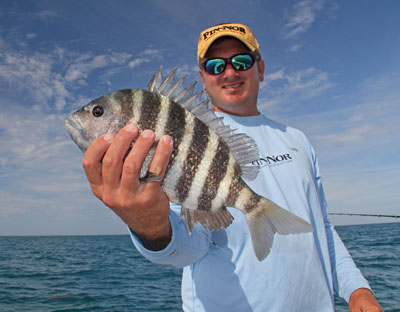
Photo by David A. Brown |
If you fish for sheepshead long enough, you'll come to know them as one of the trickiest fish in Florida waters. With mouths that are made for nibbling, these sporty fish are masters at picking away at your bait and avoiding hooks. Some say the nickname "convict fish" comes from those black and white stripes, but I think it's also due to their thieving ways.
Bait Options
Sheepshead are not very picky, so it's not hard to find a bait that they'll eat. These fish like most any crustaceans and shellfish you offer them, with shrimp topping the list of common baits. Shrimp doesn't have to be alive, but fresh is best. You'll find that a bait holder hook with barbs on the shank will help keep shrimp threaded on the hook.
A lot of times, it's smart to only use cuts of shrimp, so when a sheepshead bites, he takes the whole piece of bait and that puts the hook right in his mouth. If you use a whole shrimp, your hook can't cover the entire length of the bait and sheepshead always seem to nibble around the hook without getting nabbed.
Another way to fish your shrimp is to thread it onto a ¼-ounce jig head. This keeps the bait, hook and weight all together in a compact form that's especially effective around rock piles where a separate weight may get tangled. A similar concept is the knocker rig, which is formed by slipping a slip sinker onto your leader and tying directly to the hook. The weight slides against the hook, but a fish can pull the hook and leader through the weight so it's not spooked by any initial resistance.
Fiddler crabs are one of the top sheepshead baits, but they're sometimes hard to get. Some bait shops carry them, so I like to call ahead and reserve my order to make sure I have them. As with shrimp, live is best, but freshly frozen crabs will also work well.
For easier handling, remove the crab's big pincher. The best place to hook a fiddler crab is where the legs are attached. Insert the point, but don't push it all the way through the body. When a sheepshead bites the crab, the hook pushes through the crab and into the fish's mouth.
I like to fish fiddlers with no weight whenever possible. They can be difficult to cast when unweighted, so I'll use a light split shot about 12 inches up the leader from my hook. This benefits casting and helps get the crab to the bottom.
Of all the sheepshead baits, barnacles are my favorite. Approach pilings at low tide and scrape the "barnies" into a bucket of saltwater to keep them fresh. When hooking barnacles, run the point through the back, or flat side. Thread as many barnies as needed to make the bait the size of your thumbnail.
Barnacles are most effective when free-lined around bridge and dock pilings. If you scrape off a few fresh barnacles, the sheepshead will respond to the scent of fresh food. Drift your baited hook in this chum line and stay alert for strikes.
Rigging and Response
A sheepshead bite will be subtle; in fact, you might not even feel it. Just watch your line and if it stops sinking or if it moves off to the side, you're probably getting bit. Remember, sheepshead have tough mouths, so when you get a bite, jerk hard so your hook penetrates.
Braided line (I prefer 15-pound) helps with hook sets. It also prevents break-offs when sheepshead dash around barnacle-encrusted pilings. Go with about 18 inches of 20- or 30-pound fluorocarbon.
One of the fishing lessons I remember from my boyhood was that sheepshead are sneaky so you have to "jerk before they bite." This is one tricky fish and you'll need sharp attention and quick responses to catch them.
When and Where
Sheepshead are available all year, but you'll find them gathering in large spawning groups during February and March. Fishing during these periods of cooler water gives you the chance to catch lots of fish.
Look for sheepshead mostly around structure. You may find a few on the flats, but the greatest concentrations will be around solid habitat that offers protection and food sources. All of the bridges, reefs and rock outcroppings throughout the Bay area will hold winter sheepshead. Rock jetties like Clearwater Pass, Demons's Landing and Venice are popular spots. Also, the rock piles along the edges of Tampa Bay shipping channels offer great opportunities.
Moderately moving water is always best, but if the tide is too strong, you'll have trouble getting your bait to the bottom. You'll find that certain spots produce best on different tide stages, or direction. Only experience can tell you what works, but don't over-analyze it. Fish whenever you can and keep moving around until you find a spot that works. Remember the details of tide stage, location, etc. for future trips.
Sheepshead can be very challenging, but their tasty filets are worth the work. Handle your fish with caution, as those sharp dorsal fin spines can give you a painful wound. The skin is tough, so use a sharp filet knife and remove the large rib cage. You can cook sheepshead in a variety of ways, but I like to fry mine. The good thing is that a liberal bag limit – 15 per day, 12-inch minimum length – allows you enough to try different styles of preparation.
For weekly fishing reports, hot tips, catch photos and lots of angling resources, visit www.billmiller.com. For fishing charters in the Tampa Bay area, call (813) 363-9927.

